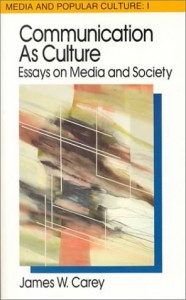In James Carey’s Communication as Culture (1989) he presents a new way of thinking about communication. Carey challenges established perspectives, where communication is viewed merely as transmission of information, and promotes studying communication from a cultural perspective. He draws upon the work of previous scholars (Clifford Geertz , John Dewey, Max Weber, Walter Lippmann, etc.) to apply a cultural studies methodology to the study of communication. Carey seeks to “demonstrate how media of communication are not merely instruments of will and purpose but definite forms of life: organisms, so to say, that reproduce in miniature the contradictions in our thought, action, and social relations.” (9)
Carey suggests two ways of viewing communication. The transmission view (the more common of the two) uses terms like “imparting”, “sending”, and “transmitting” to convey one party giving information to another. It involves “the transmission of signals or messages over distance for the purpose of control.” (15) This view connotes the desire for control and power as it is derived from the spread of Europeans in their global colonization, and although technology and science have separated communication from transportation, some of the residual implications remain.
Carey opposes this with the ritual view, which uses terms like “sharing”, “participation”, and “association”. This view is “directed not toward the extension of messages in space but toward the maintenance of society in time; not the act of imparting information but the representation of shared beliefs.” (18) Like the transmission view, the ritual view has grown away from its religious origins but still retains some of its metaphoric roots. There is an intellectual aversion to this view because of the unfortunate assumption that science somehow operates in a vacuum whereas culture is full of human error. Thus any method that studies the activity of people within a culture must be flawed. So for example, a transmission view of a newspaper would see it as a medium for disseminating disinformation to exert control over a population; a ritual view would see reading the newspaper as a shared experience by people in which their worldviews are collectively shaped and confirmed.
Particularly in America, communication studies (both mass and interpersonal) “have aimed at stating the precise psychological and sociological conditions under which attitudes are changed, formed, or reinforced and behavior stabilized or redirected.” (44) American studies of communication have not given serious consideration to the relation of forms of expression (art, religion, etc.) and social order—how do meaningful symbols, and symbolic acts, affect real change?
Cary suggests conceiving of communications as a cultural science as that will constitute a more “human” model and deal with experience as it normally is encountered. Culture is complex web of meaning which humanity has created, and “we are challenged to grasp the meanings people build into their words and behavior and to make these meanings, these claims about life and experience, explicit and articulate so that we might fairly judge them.” (59) People exist simultaneously in many different sub-cultures and a cultural approach to communication studies offers us helpful insights that traditional (transmission) views do not. “Culture” and “Communication” are not neatly delineated, finite artifacts or practices. A ritual view allows for a more nuanced understanding of human societies where the complexities of culture (and the influential, dynamic activities and forms of communication) are accounted for. Carey desires to “press forward with a form of cultural studies that does not perforce reduce culture to ideology, social conflict to class conflict, consent to compliance, action to reproduction, or communication to coercion.” (109)
The second half of Carey’s book explores more specific facets of technology and culture. He wants to debunk the rhetoric of an electronic utopia. “Electronics is neither the arrival of apocalypse nor the dispensation of grace. Technology is technology; it is a means for communication and transportation over space, and nothing more.” (140)[1]Carey offers a brief history of communication studies in North America and traces the relation between time and space from local to global. He also traces the history of the notion of “future” as it has been used to propel us along with false promises of newer, better forms of human communication and the eradication social issues altogether. Carey concludes with a detailed look at the oft-neglected technological importance of the telegraph, the advent of which marked the first time in history that information and transportation were separated. Most of the attention Carey’s Communication as Culture has received has been paid to its first half. The ideas he lays out, although fairly simple, are a radical break from the way communication has traditionally been studied.
[1] It is perhaps here that Carey’s ideas seem somewhat dated; he was clearly writing in a pre-internet era.

